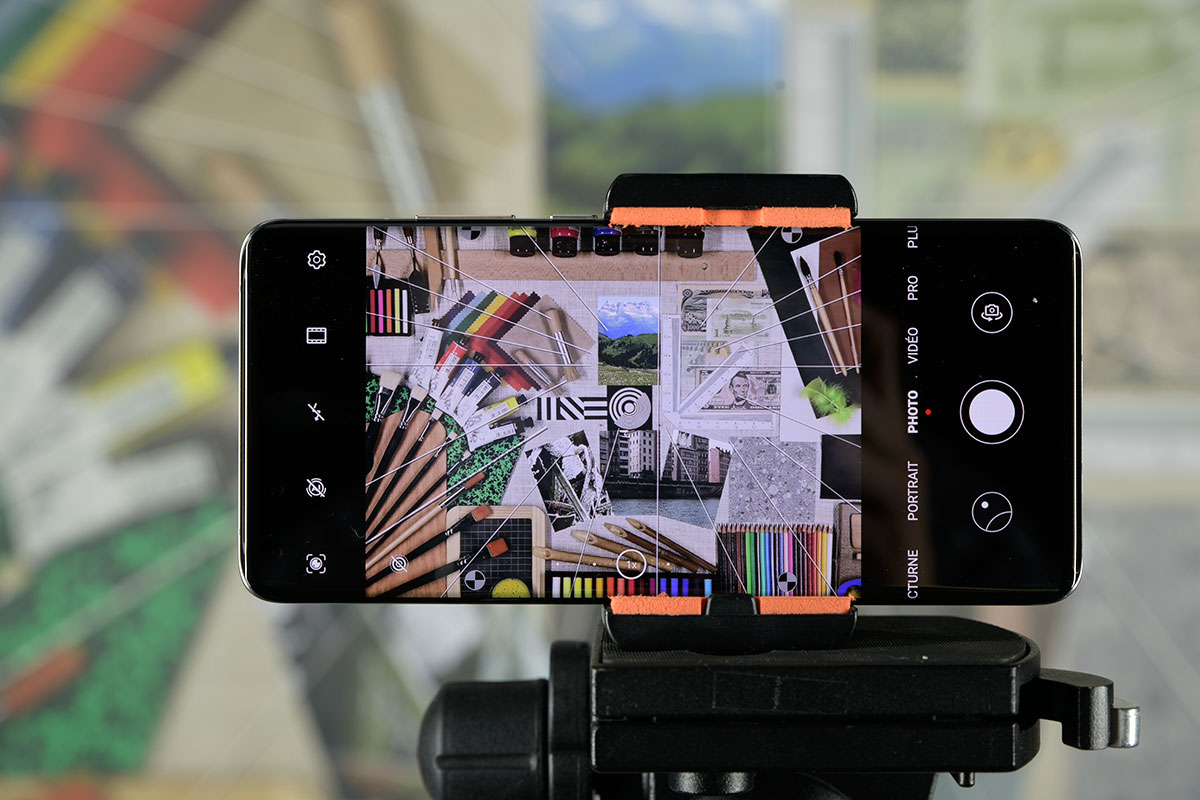Camera
Huawei’s P40 Pro is the company’s latest high-end smartphone and features the recent Kirin 990 5G chipset, a 6.58-inch Full-HD+ OLED display with rounded edges, and a dual front camera. Huawei tends to use the P-series models to showcase the company’s latest mobile camera technologies, and the brand-new P40 Pro, its P-series flagship device for 2020, is no different, with camera specs and features that any competitor will find hard to match. Let’s take a closer look.
Main camera
The primary camera comes with a very large 1/1.28″ 50MP Quad-Bayer sensor that produces 12MP image output. As with other devices with similar sensors, it uses pixel binning to increase dynamic range and low-light capabilities. The lens features an f/1.9 aperture and nominal 23mm-equivalent focal length; however, Huawei crops the field of view to a more conventional 27mm. This decision was presumably made in order to design a thinner camera unit, but it should also help with reducing such artifacts as corner softness and distortion. Optical image stabilization, which can be challenging to implement on such large image sensors, is on board as well.
Ultra-wide camera
Like with the Mate 30 Pro, Huawei implements a large and high-resolution image sensor (40MP 1/1.54″) in its ultra-wide camera, which combined with a fast f/1.8 lens, should make for excellent low-light image quality. The downside of such a large sensor in the ultra-wide is lens design. It’s a challenge to design a lens that provides a very wide angle of view and still fits into the thin body of a high-end smartphone. This is why Huawei settled on a compromise at 18mm, which is noticeably wider than the main camera, but not as wide as that of some competitors, such as the latest Samsung devices and iPhones, which offer 12mm and 13mm lenses, respectively.
Tele-camera
The P40 Pro’s tele-camera comes with similar technology to last year’s P30 Pro. The module is optically stabilized and uses folded optics to achieve a 5x optical zoom factor (125mm equivalent).
“Field-of-view fusion” zoom
The P40 Pro doesn’t rely just on hardware alone for zooming, however. Like the P30 Pro, the P40 Pro uses software systems that Huawei calls field-of-view fusion and AI RAW, a combination of optical and algorithm-powered digital zooming that adapts to the chosen magnification factor. Only the primary camera is used for up to 2x magnification; the tele-camera takes over from 5x and longer. For intermediate zoom factors, the P40 Pro uses a fusion algorithm that combines image data from both cameras, merging several RAW frames from the main and tele cameras into one high-resolution frame, which is then cropped for zooming.
For optimal detail, the 5x tele-cam records image data at the center of the frame; it uses AI-refined image data from the primary camera to fill in the “missing” image areas around the edges. A deep learning algorithm improves detail on fine patterns and textures—quite an impressive feat, considering that autofocus, white balance, and other image parameters of both cameras all have to be in perfect sync for good results.
At the long end, the camera is capable of achieving a 50x zoom factor using a combination of optical zoom and super-resolution processing that stacks multiple RAW frames from the tele-cam.
Improved bokeh mode with AI RAW and super-resolution
While the P30 Pro used AI RAW only for zooming, the P40 Pro now applies the technology to most camera modes, including bokeh. This means that as with zoom shots, bokeh images from the new model offer a wider dynamic range. The camera uses the 50MP high-resolution sensor and an AI RAW-powered super-resolution algorithm to generate an image with a 54mm-equivalent focal length and very good detail rendering. Data captured by a time-of-flight (ToF) laser measures the distance to objects in the scene, and is then used to confirm and fine-tune the initial depth-map that the primary and super-wide cameras generate.
Improved white balance and color rendering with multispectral sensor
The P40 Pro also comes with a new white balance system that uses a semantics-based neural network and data-driven methods for more accurate white balance. The system also gets help from a multispectral sensor that can measure specific colors more accurately than the image sensor.
Autofocus with dual phase detection on all sub-pixels
The new autofocus system comes with dual phase detection on all sub-pixels and can use all pixels for autofocusing. In low light, the system also makes use of subject distance information that the ToF laser sensor captures.
Key camera specifications:
- Quad camera setup, including ToF sensor
- Primary: 50MP 1/1.28″ sensor (12MP output), 23mm-equivalent (1x defined as 27mm) f/1.9-aperture lens, full-pixel Octa-PD, OIS
- Ultra-wide: 40MP 1/1.54″ sensor, 18mm-equivalent f/1.8-aperture lens, PDAF
- Tele: 12MP 1/3.56″ sensor, 125mm-equivalent f/3.4-aperture lens, PDAF, OIS
- ToF 3D depth-sensing camera (78-degree FOV)
- LED flash
- 4K video, 2160p/60fps (2160p/30fps tested); default is wide-angle camera 1080P/30fps
- Multispectral color temperature sensor
Please note: The Huawei P40 Pro was tested with European firmware which by default has AI set to off. In other regions the feature is activated by default. The camera firmware used for the DXOMARK tests is not yet currently available to consumers. Huawei will make it available as an update in the near future. Please also note that because of COVID-19 restrictions in France, we were limited in shooting a more thorough series of outdoor photographs that normally would be included in the review.
About DXOMARK Camera tests: For scoring and analysis in our smartphone camera reviews, DXOMARK engineers capture and evaluate over 1600 test images and more than 2 hours of video both in controlled lab environments and in natural indoor and outdoor scenes, using the camera’s default settings. This article is designed to highlight the most important results of our testing. For more information about the DXOMARK Camera test protocol, click here. More details on how we score smartphone cameras are available here.
Test summary
At 128 points, the Huawei P40 Pro achieves an impressive new top score in the DXOMARK camera ranking, leaving even the best competitors in the dust. Its Photo score of 140 is also an impressive new record, based on an impeccable performance across all sub-categories.
The main camera offers a very wide dynamic range and class-leading texture/noise balance, making it an excellent option for shooting in any condition, from challenging high-contrast scenes to very low light. The zoom is particularly impressive, and the 5x tele-camera in combination with the main camera, along with innovative computational methods. achieves outstanding detail and low noise levels across all tested zoom factors. At the other end of the focal length spectrum, the P40 Pro’s ultra-wide camera offers the best image quality we have seen on an ultra-wide, with excellent dynamic range, very good detail, and low noise. The only downside is the ultra-wide’s 18mm focal length, which does not let you squeeze quite as much scene into the frame as many direct competitors (and therefore lowers the Wide score).
Bokeh mode also does an excellent job, with good subject isolation and pleasant bokeh shape, as well as very good image detail and dynamic range. The phone’s autofocus system is one of the best we have tested to date, delivering flawless performance in all tested lab and real-life conditions.
But the P40 Pro is not only an outstanding smartphone for still image capture. At 105 points, it also tops our ranking for Video. Like for stills, the camera does not show any real weaknesses in any of the test categories and is either the best or among the best in all of them. Video footage shows good exposure and wide dynamic range, with only some minor clipping in challenging high-contrast scenes; and as long as you are not recording under low tungsten light, white balance and color rendering are mostly accurate.
The P40 Pro renders detail pretty well, but we occasionally saw a loss of fine textures. Noise is very well under control in good light, but temporal noise becomes visible under low tungsten illumination. In addition, Video autofocus works as well as that for stills, delivering quick and reliable focus with good tracking, and the stabilization system effectively keeps things steady when walking or holding the camera still in your hands.
Photo scores explained
The Huawei P40 Pro achieves a Photo score of 140 points, making it the best device for still images to date. The Photo score is calculated from sub-scores in tests that examine different aspects of a device’s performance for still images under different lighting conditions. In this section, we take a closer look at how these sub-scores were determined and compare image quality against some key competitors.







Комментарии
Отправить комментарий